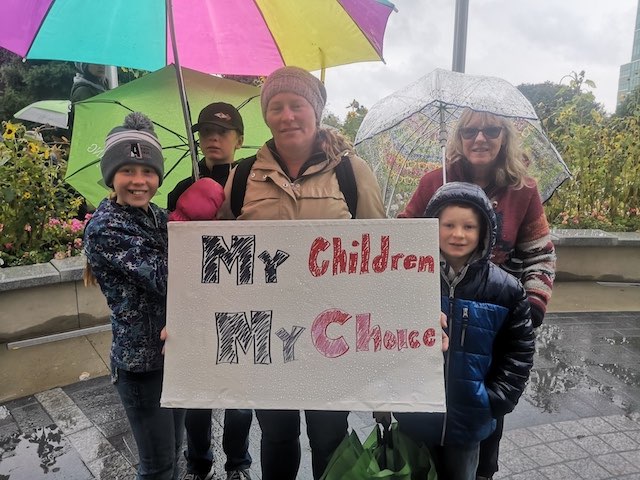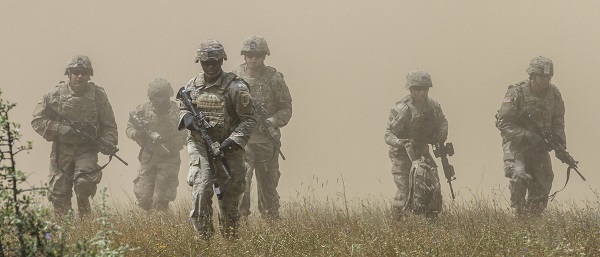Opinion
1 Million March 4 Children announces second event Saturday, Oct 21 – How should we feel about this?




- These protests are supported by a big tent of far-right and conspiratorial groups, including Christian Nationalists, COVID-19 conspiracy theorists, sovereign citizens, and anti-public education activists.
Sounds dangerous. Far-right and conspiratorial groups, Christian Nationalists, COVID-19 conspiracy theorists, sovereign citizens, all mixing it up with anti-public education activists. No wonder I was afraid to go at first! Good thing I don’t depend on the AntiHate.ca website to plan my outings.
Come to think of it I’ve got a couple of questions for AntiHate.ca.
1) Are Christian Nationalists ‘far-right’ or ‘conspiratorial’? Can they be just Christians who like their country a lot? If not, what do we call Christians who like Canada? Just wondering.
2) Are the COVID-19 ‘conspiracy theorists’ the ones who correctly (if annoyingly) warned the lock downs / masks / 1, 2, 3, 4 doses of vaccine would not stop the pandemic? or were they the ones who incorrectly believed all those things would bring that pandemic to an end? Can you see how that could be confusing in 2o23?
3) I didn’t know I had to be afraid of sovereign citizens and anti-public education activists. Can I let my children out of the house while they still exist in Canada?
It’s important there are groups like AntiHate.ca. It’s important Canadians always remember that no matter how much we disagree, almost every single person wants to live their lives in freedom and simply enjoy opportunities. When we descend into hatred, we take society down with us. So thank you AntiHate.ca for watching out for us.
Were there incidents at hate at the 1 Million March 4 Children? AntiHate.ca found some examples. I did not see or hear of any incidents at the Red Deer event. Part of the credit goes to the police. They did a wonderful job of patrolling between the opposing sides in a very relaxed and friendly manner that certainly calmed the tension people would otherwise have felt.


Standing on the sidewalk as protestors streamed past me, I was struck by how different the 1 Million March 4 Children felt compared to other protests I’ve attended.
This was a protest of families. There were pregnant women, new mothers and fathers with their young children, and lots of grandparents. It also featured an intriguing and beautiful mixture of cultures. As protestors strolled past I was reminded of that feeling you get from the multi-cultural festivals that mark so many Canada Day Celebrations.




Fact: On September 20, 2023 a vast array of Canadians representing many cultures and beliefs united at Red Deer’s City Hall Park for the 1 Million March 4 Children.
But: Unlike Canada Day, it felt a little bit like we were going to get in trouble just for being here. Maybe that’s why very few politicians dared to come out in support of this group. I did see Red Deer South MLA Jason Stephan and Red Deer Catholic School Board Member Monique LaGrange. Jason has never been frightened of zagging where other politicians are zigging. As for Monique, she’s been disciplined for expressing her opinion recently and probably felt she had nothing more to lose by being associated with the people AntiHate.ca is warning us about.
Canada’s Prime Minister is convinced the people streaming past me were “phobs”… Transphobs, homophobs, and biphobs (I think he may have invented the last one just as he was writing the post below). According to our Prime Minister hundreds of Central Albertans and the tens or hundreds of thousands of Canadians who gathered on September 20 were there to ‘manifest their hatred’ of 2SLGBTQI+ people. Here’s Trudeau’s post on X.

The Muslim Association of Canada strongly condemned Trudeau’s remarks and called for an apology that has yet to make it’s way into the line up of apologies PM Trudeau seems to make on a daily basis. Here’s part of their statement.
- By characterizing the peaceful protests of thousands of concerned parents as hateful, Canadian leaders and school boards are setting a dangerous precedent of using their position of influence to unjustly demonize families, and alienate countless students.
- On Wednesday September 20th, thousands of Muslims, joined by other faith-based groups, protested to raise their concerns, calling for their rights as parents in relation to their children’s education. Their intent was to be heard, not to sow division. Parents should have the absolute right to advocate for the wellbeing of their children.
As I streamed through my social media feeds last week I could see some of my friends (who I did not see at the protest or counter protest) apparently agree with Trudeau. The most common post was the “no space for hate” meme which is really a beautiful message even if it might be a bit too sarcastic when aimed at the vast majority of those who marched. (I’m OK with sarcasm. I think my family may have invented it.)

By using the word ‘hate’ they seem to be implying the protestors are hateful. Maybe they can come to the next march in October to see for themselves. I did not see messages of hate from the protestors OR from the counter protestors in Red Deer. You can see excellent examples of the signage from both sides in the photos below which show the signs on opposite sides of the street (and the debate).


On top of the signs there were also competing slogans. Chants of “Leave our kids alone” from the protestors were so loud it was a bit difficult to hear the opposing chant. I thought I heard “I was born like this” from the counter protestors.
I heard another chant from the protest organizer on his megaphone. “Don’t interact with the counter protestors. They have a right to be here too.” All in all the Red Deer protest was a bit loud, but far more civilized than advertised. I guess it felt a little bit like democracy is supposed to feel like.
As the protest ended I even witnessed one protestor walk up to a group of 5 or 6 counter protestors. He said (I’m paraphrasing) “I may not agree with you about much, but I respect your right to be here and I just wanted to say thank you for expressing your opinions peacefully.” That was quite a moment for the counter protestors who all looked relieved as they were likely expecting a confrontation. I admit I was stunned. It caught me by surprise and I was unable to get a photo or video in time.
As I looked through the protest signs and briefly chatted with people streaming past me it was clear there was one overwhelming message. The protestors clearly want to be the ones to teach their children about gender ideology. Others are far more concerned about the idea that schools would be keeping secrets with students from their parents who pay the taxes that support the whole system.


I leave the final words to Tim Hoven. Tim is a politically active Central Albertan who tried to take on his local UCP MLA Jason Nixon in a nomination and then ran unsuccessfully as an Independent candidate against him when his nomination was disqualified. Hoven was the local organizer and the main speaker at the Red Deer version of 1 Million March 4 Children.
Media
Reporters determined to drive their industry and its reputation into the abyss one Tweet at a time

Last week, my column for The Hub was about why journalists, for the sake of journalism, should avoid posting on Twitter/X.
It took mere hours for my advice to be wrapped up in a ball and shoved right back at me when Robert Fife, a reporter of many years experience (he’s even older than I am) and the Globe and Mail’s Ottawa bureau chief, posted in response to the House of Commons’ vote on a Conservative motion to approve pipelines that:
“Conservatives persist with cute legislative tricks, while the government tries to run a country.”
The Rewrite is a reader-supported publication.
To receive new posts and support my work, consider becoming a free or paid subscriber.
While he’s free to do so and obviously views things differently, it is quite beyond me why the bureau chief of a distinguished journalism organization would expose himself so casually to accusations of bearing a bias – particularly given public concern about government funding of media – and so I responded by sharing Fife’s post with the comment:
“I’m old-fashioned enough to think reporters shouldn’t be blatantly stating biases. Not a great way to retain public trust.”
Now, I was aware that Fife was sharing a headlined opinion column by a colleague, Robyn Urback. But Urback is perfectly capable of promoting her own work and if Fife’s sole motivation was to neutrally share her column, it would’ve been fine if he had posted something like: “Here’s one perspective on yesterday’s House of Commons vote.”
Some people suggested the post was OK because it was only sharing someone else’s viewpoint and a headline. But Fife’s appearance on CBCNN’s Power and Politics – in which he enthusiastically described the Opposition as “childish” and criticized it for criticizing the government – made it appear the Tweet was otherwise motivated. Not everyone in today’s newsrooms shares my view that reporters should do everything in their power to be viewed as objective. Fair enough. While the aspiration remains popular with the public, it is no longer favoured by many, maybe even most, modern journalists.
Fife’s been a good reporter for decades going back to long before Twitter. He’s been announced as the 2026 recipient of the Public Policy Forum’s Hy Solomon award for excellence in public policy journalism. There are also some exceptionally good reporters at the Globe and Mail such as Grant Robertson, who has won nine National Newspaper Awards – more than anyone, ever, and eight more than me. There is no evidence I can find that Robertson, like a lot of other very good journalists, even has an account on X/Twitter. I have absolutely no idea or suspicions concerning what he thinks about anything going on in the world and I think that is how journalists should aspire to be perceived. But when social media posts by other reporters bring into question journalists’ reputations as fair brokers of the events of the day, his prudent behaviour isn’t enough to keep the entire craft from suffering reputational damage. As the old saying goes, newspapers don’t report when airplanes land safely – a phrase that applies equally to reporters, of which, according to the latest Global Media and Internet Concentration Project report, there were 1,600 fewer in Canada last year.
All that said, I don’t think anyone cares enough to do anything about it. Despite considerable evidence detailing journalism’s decline as a trusted institution, the overwhelming majority of its practitioners appear to me to have no intention whatsoever of altering course.
It looks like time has passed me by. As Leonard Cohen sang, “I’m old and the mirrors don’t lie.” So I will just continue to tilt at windmills for a little longer and then decide if there aren’t more rewarding things to do.
So Tweet away, journos, Tweet away. Tweet all the way into the abyss.
The colloquial nature of many newsrooms continues to fascinate, the latest example being treatment of Bill C-9, which expands the powers of Canada’s hate criminal speech legislation. Already problematic from a free speech perspective, the deal Justice Minister Sean Fraser struck with the Bloc Quebecois to ensure its passage has alarmed both the Canadian Conference of Catholic Bishops and the National Council of Canadian Muslims.
That’s because in exchange for the Bloc’s support, Fraser will amend C-9 so that it removes the exemption given to statements made based on sincerely held religious beliefs. The exemption states: “if, in good faith, the person expressed or attempted to establish by an argument an opinion on a religious subject or an opinion based on a belief in a religious text.”
But, just as our media refuse to acknowledge developments beyond our borders on trans issues and health care models, they remain rube-ishly reluctant to look at what happens when quoting from the Bible becomes a police matter. I wrote about it elsewhere and, given that I am planning a Christmas break, will re-post that piece next week. In the meantime it will be interesting to see if any Canadian media or commentators pick up on the case of Päivi Räsänen, a medical doctor and Member of the Finnish Parliament. She and Bishop Juhana Pohjola of the Evangelical Lutheran Mission Diocese of Finland, twice acquitted, are awaiting the outcome of their third trial on allegations of criminal hate for quoting passages of the Bible regarding a church Pride event. If found guilty, they will face up to two years in prison, the same as in Canada.
The bad news for journalists working within traditional media structures continues.
The Nieman Lab predictions for 2026 forecast that Artificial Intelligence will continue to grow as a source of information for the public.
The good news?
“Tech companies will face pressure in the year ahead to bolster the information ecosystem.”
The bad news?
“Tech companies will realize they don’t need journalism to give people the answers they need.”
The conclusion?
“The threats we (journalists) face are existential, but we can reframe them as opportunities.”
Postmedia columnist Brian Lilley is definitely playing journalism with his elbows up these days.
Last week, he challenged his colleagues in the industry to question the activist group Coastal First Nations on its funding by US interests.
“Here’s an open challenge to the Parliamentary Press Gallery who will be covering the CEO of Coastal First Nations appearing in Ottawa,” he posted on Twitter. “Ask them what rights and title they hold to any of the land in question.
“Ask them about American funding.”
Near as I could tell, he didn’t get any takers and the industry will continue to present the anti-pipeline group as organic. But, just in case, I checked and Lilley’s response was “Hahahahahahhaha!”
Earlier, he firmly put CBCNN Power and Politics host David Cochrane in his place with a Facebook post stating “I’ve never seen an anchor in any country, on any network, push left-wing Liberal talking points as hard as Cochrane.”
Whew! Brian won’t be popular at parties.
Finally, a bouquet to Peter Mazereeuw of The Hill Times for the literary flourish with which he described the anonymous sources so routinely used by press gallery journalists who pretend they aren’t authorized to speak.
Justice Minister Sean “Fraser is currently in a bit of hot water with the PMO, which sent forth some of its anonymous flying monkeys yesterday to tell the CBC that he had not gotten its approval for his deal with the Bloc Québécois ….”
Remember that term.
Happy Hannukah. May your candles burn bright.
Readers will notice a new DONATE button has been added. Please consider making use of it and help us save journalism from bad journalism.
(Peter Menzies is a commentator and consultant on media, Macdonald-Laurier Institute Senior Fellow, a past publisher of the Calgary Herald, a former vice chair of the CRTC and a National Newspaper Award winner.)
The Rewrite is a reader-supported publication.
To receive new posts and support my work, consider becoming a free or paid subscriber.
Crime
Hero bystander disarms shooter in Australian terror attack

Insane footage shows a bystander attacking and disarming one of the terrorists, who appears to have been armed with a long rifle, during today’s shooting attack on an event celebrating Hanukkah at Bondi Beach in Sydney, Australia. pic.twitter.com/mJceco22bJ
— OSINTdefender (@sentdefender) December 14, 2025
The chaos that struck Australia on Sunday night produced one moment of astonishing courage: a Sydney shopkeeper, armed with nothing but instinct and grit, charged a gunman at Bondi Beach and wrestled the rifle out of his hands as terrified families ran for cover. Authorities say the act likely prevented even more deaths in what officials have already called an antisemitic terror attack that left 12 people dead and dozens wounded during a Hanukkah celebration along the water.
The hero has been identified as 43-year-old fruit shop owner Ahmed Al Ahmed, a father of two who happened to be nearby when gunfire erupted at the beachfront event “Hanukkah by the Sea,” which had drawn more than 200 people. Footage captured the moment he marched toward the shooter, grabbed hold of the rifle, and overpowered him in a brief, violent struggle. As the gunman hit the pavement, Al Ahmed momentarily pointed the weapon back at him but didn’t fire, instead placing it against a tree before another attacker opened up from a bridge above. He was hit in the hand and shoulder and is now recovering after emergency surgery.
A relative told Australia’s Channel Seven that Al Ahmed had never handled a gun in his life. “He’s a hero — he’s 100 percent a hero,” the family member said. New South Wales Premier Chris Minns echoed the praise, calling the scene “unbelievable,” adding, “A man walked up to someone who had just fired on the community and single-handedly disarmed him. Many people are alive tonight because of his bravery.”
Police say two shooters stepped out of a vehicle along Campbell Parade around 6:40 p.m. and began firing toward the beach. One gunman was killed, the other is in custody in critical condition. Detectives are also investigating whether a third attacker was involved, and bomb units swept the area after reports that an explosive device may have been planted beneath a pedestrian bridge. The toll is staggering: 12 dead, including one shooter, and at least 29 wounded — among them children and two police officers.
Prime Minister Anthony Albanese condemned what he called “a targeted attack on Jewish Australians on the first day of Hanukkah,” saying, “What should have been a night of joy and peace has been shattered by this horrifying evil attack.” Emergency crews flooded the beach as hundreds of panicked people sprinted away from the gunfire. Video shows one attacker firing down toward the sand from the bridge behind Bondi Park before being shot himself in a final standoff captured by drone footage. Both gunmen appeared to be carrying ammunition belts, with witnesses estimating up to 50 rounds were fired.
Australian police have cordoned off properties linked to the suspects and continue to canvass Bondi for additional threats. What remains clear is that Sunday’s attack was met with extraordinary acts of self-sacrifice, none more dramatic than a shopkeeper from Sutherland who walked into gunfire to stop further slaughter.
-

 Crime1 day ago
Crime1 day agoTerror in Australia: 12 killed after gunmen open fire on Hanukkah celebration
-

 Crime1 day ago
Crime1 day agoHero bystander disarms shooter in Australian terror attack
-

 Business1 day ago
Business1 day agoInflation Reduction Act, Green New Deal Causing America’s Energy Crisis
-

 Daily Caller2 days ago
Daily Caller2 days ago‘There Will Be Very Serious Retaliation’: Two American Servicemen, Interpreter Killed In Syrian Attack
-

 Business2 days ago
Business2 days agoFuelled by federalism—America’s economically freest states come out on top
-

 Automotive2 days ago
Automotive2 days agoPoliticians should be honest about environmental pros and cons of electric vehicles
-

 Media1 day ago
Media1 day agoReporters determined to drive their industry and its reputation into the abyss one Tweet at a time
-

 International1 hour ago
International1 hour agoAt Least 15 Killed In Shooting Targeting Jewish Community At Australia’s Bondi Beach, Police Say




